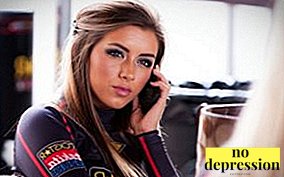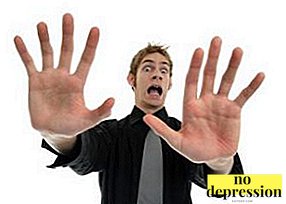Blue colour - crown of cold colors and one of the three primary colors, the mixture of which in certain proportions makes it possible to obtain any of the complementary colors.
Blue color in psychology It is considered a color that personifies peace, wisdom and patience.
What does it mean and what does it mean?

The blue color gives rise to many different shades, and the most famous ones are azure, celadon, ultramarine, indigo, cornflower.
Also, blue and purple are considered shades of blue.
Interesting Blue Facts:
- In the Christian art of iconography, blue is a symbol of the Virgin Mary and spirituality in general. Hymathion (outerwear, cape) of Jesus Christ is also traditionally painted in this color.
- The ancient Egyptians considered the blue color of truth.
- In Buddhism, the blue color represents the East.
- Studies have shown that blue can reduce crime. An experiment was conducted in one of the Japanese cities, which showed that the use of blue in street lighting reduced the crime rate by almost 10%.
What does blue color mean in psychology? Find out from the video:
What is associated and what does it symbolize?
Perhaps, main associationarising at the thought of blue is the sky.
Cloudless skies throughout the existence of mankind have been a symbol of peace, tranquility, tranquility, and the same characteristics are attributed to blue.
The second common association with blue is serene sea. In many works of art, the sea is called blue, as, for example, in the fairy tale Pushkin's Golden Fish.

Also a frequent association is flowers.
Flowers, whose petals are painted blue, a lot.
These are cornflowers, chicory, proleski, lobelia, aconite, periwinkle, bell, forget-me-nots. Also in many types of flowers you can find varieties having a blue color, such as blue poppy, blue tulip.
In animal colors blue color is rare, except that some birds, mostly those that live in the southern and eastern zones of the world, can boast blue plumage, such as the Taiwanese thrush, some parrots, crowned pigeon.
Blue color primarily symbolizes wisdom, peace, faith, eternity, serenity, poise, happiness, spirituality. He, like other cold colors, is extremely attractive to intellectuals and creative people.
The classic blue color is often given positive characteristics, but the darker the shade, the more negative features are attributed to it.
Dark blue color more often than pure blue, associated with grief, sadness. It feels like more severe, oppressive, especially if you use it as the main one in the interior.
In the color test Lusher blue color means satisfaction, calmness, poise.
Who likes it and why?

Blue and blue are traditionally attributed to masculine colors, and red and pink to feminine.
But for the most part it is marketing trickrather than having a real connection between sex and color.
A man of any gender can find attractive various shades, and the girl will not grow male genitals, if you wear blue pants on her.
According to a large study conducted in 2003, about 35% of women and 55-57% of men reported that consider blue as their favorite color.
Men who prefer blue often have the following personality traits:
- Pedantry. Attention to detail, perfectionism and practicality are often present in the nature of men who choose blue. They strive to do everything as best as possible, reconcile every detail and carefully adhere to the rules and instructions. On the one hand, this is good, because the quality of work will be higher, but due to excessive pedantry, the speed of its implementation decreases.
Also pedantic people tend to develop neurosis and anxiety disorders.
- The pursuit of stability. For such a man, poise and calm in everything is a priority. To make life clearer and more stable, they often prefer to follow schedules.
- Ability to resolve conflicts. Blue is the color of the world. Men who choose him consider conflicts, quarrels, fights, scandals unacceptable and always seek to solve all problems peacefully, for example in the process of dialogue. Often, they act as a kind of peacemakers for quarreling friends or colleagues.
- Self confidence. Men who prefer the blue color, know what they want to achieve, and realize that they have the strength to implement their own plans.
- A responsibility. Pedantry is complemented by a sense of responsibility; therefore, such men perfectly manifest themselves in work, especially in the one that requires the utmost precision and care. And if the mistake was made, they recognize it and try to eliminate it.

Womenwho choose the blue color, have similar features of the character that men prefer it.
They are resolute, diligent, prefer to solve problems through diplomacy, careful, attentive.
However, they:
- Tend to hold back emotions. This character trait does not mean that these women are cold (although this feature may be inherent to them), but they seek to control their own lives as much as they can, and if the situation requires non-emotional objectivity, they will try to do everything possible to achieve this.
- Perfectly able to systematize information. This allows them to quickly select the most valuable from the total amount they receive, and assimilate it in order to apply and achieve the planned goal later. This feature also helps them plan and define key tasks more effectively.
- Have developed empathy. Empathy - the ability to deeply empathize with the interlocutor, to understand his feelings and in essence feel them on a par with him. This feature is rarely present in men, because their gender role imposes on them emotional detachment, as a result, their ability to understand and comprehend emotions remains undeveloped (and this often adversely affects their mental state). Women successfully use it in diplomatic conversations, during dialogues with relatives, in the process of trying to reconcile quarreling friends.
- True to partner. Such women are usually monogamous and usually do not have the desire to start a relationship with someone, if those that already exist are satisfied with everything. This feature is also inherent in men who love blue.

Also, women who love a deep blue color may have moderate shyness.
Both women and men with this color preference, as a rule, they are interested in sciences and creativity, tend to self-development and improvement of skills.
Childrenpreferring blue color, are characterized by balance, obedience, prefer to think, and after acting, they seem reasonable not by years, at an older age they may be interested in philosophy.
They are not peculiar selfish perception of the world, they are open to friendship and sincere.
Who likes blue? About this in the video:
What does dislike for blue mean?
People who don't like blue color often have the following character traits:
- excessive activity, restlessness;
- stubbornness;
- inconstancy;
- the desire to show themselves in the best light;
- lightheadedness

Also, blue people may not like people, avoiding everything that may cause them to associate with melancholia, sadness, sorrow.
Use in advertising
Blue color is widely used in marketing, especially when developing logos and interface design.
The main color of the lion's share of popular social networks, such as Facebook, Vkontakte, Twitter, is blue or blue, and this is no accident: these colors most users associate with reliability, trust, do not weight the interface and do not have an irritating effect on eyesight.
Also, blue color is much less common than most other colors, causes any negative emotions, so it is perfect as an accent shade.
Blue, like other shades of the cold spectrum, is often used. to attract attention creative people and intellectuals to the product.
Also, this color is able to successfully fit into a creative, excessively shocking advertising, designed for a narrow audience, and in an advertisement aimed at the general population.
How does it affect a person?

Colors able to moderately affect on the somatic condition and a little stronger - on the mental state, which is confirmed by various studies, for example, that related to the connection between the crime rate and the color of lighting in the streets.
Therefore, to the selection of interior colors important to be careful and take into account the peculiarities of the influence of each of the colors on the well-being, especially in cases when people with mental diseases or who are predisposed to have to be in the premises for a long time.
Features of the effect of blue on well-being:
- Blue color is capable “Cool” angry people, mitigate the severity of aggressiveness in the character. Its light shades have a calming effect on people, mitigate the severity of stress, and have a positive effect on the course of mental diseases, especially neuroses.
- At the same time, blue is negative affects the performancetherefore, it is rarely chosen as the primary color in corporate interiors.
People who are constantly in the room with the predominant blue, especially if it is saturated blue and dark blue, the mental state worsens.
- According to the ideas of color therapists, blue able to lower blood pressure and body temperature, slow pulse, it also has a positive effect on the functioning of the pituitary, bone system, organs of sight, respiration, thyroid gland, reduces pain.
- Blue and shades are recommended to use. for registration of bedrooms, because it does not have a stimulating effect on the nervous system, but, on the contrary, calms it, speeding up sleep.
Who is suitable in clothing or interior?

Experts advise people to wear blue clothes and include them in their home interiors prone to frequent mood swingsin whose lives there is a lot of stress and anxiety.
It will also help unbalanced, aggressive people to better control themselves.
Since blue is associated in most people with wisdom, poise and tranquility, it is recommended to wear blue clothes at negotiations if a person wants to present himself as a reliable partner.
How to use blue in the interior? Watch the video:
Negative characteristic in psychology
The main negative aspects of people who love blue color:
- excessive emotional coldness;
- self-love and arrogance;
- rancorous.
The blue color, especially its dark shades, is rather depressive, since it is often associated in people with grief and sadness.
His pronounced coldness not all people have a positive effect, and even a person who has always believed that he loves blue, life in the interior with an abundance of this color may not be to his liking.
Dark and excessively bright shades of blue as the main color in the design of rooms better not to usehowever, they are well suited as accent colors.
What is the main combination of blue color in clothes? Tips:



